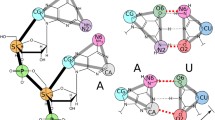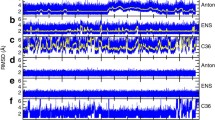Abstract
Far from being a passive information store, the genome is a mechanically dynamic and diverse system in which torsion and tension fluctuate and combine to determine structure and help regulate gene expression. Much of this mechanical perturbation is due to molecular machines such as topoisomerases which must stretch and twist DNA as part of various functions including DNA repair and replication. While the broad-scale mechanical response of nucleic acids to tension and torsion is well characterized, detail at the single base pair level is beyond the limits of even super-resolution imaging. Here, we present a straightforward, flexible, and extensible umbrella-sampling protocol to twist and stretch nucleic acids in silico using the popular biomolecular simulation package Amber—though the principles we describe are applicable also to other packages such as GROMACS. We discuss how to set up the simulation system, decide force fields and solvation models, and equilibrate. We then introduce the torsionally constrained stretching protocol, and finally we present some analysis techniques we have used to characterize structural motif formation. Rather than defining forces or fictional pseudoatoms, we instead define a fixed translation of specified atoms between each umbrella-sampling step, which allows comparison with experiment without needing to estimate applied forces by simply using the fractional end-to-end displacement as a comparison metric. We hope that this easy-to-implement solution will be valuable for interrogating optical and magnetic tweezers data on nucleic acids at base pair resolution.
Access this chapter
Tax calculation will be finalised at checkout
Purchases are for personal use only
Similar content being viewed by others
References
Lenn T, Leake MC (2016) Single-molecule studies of the dynamics and interactions of bacterial OXPHOS complexes. Biochim Biophys Acta Bioenerg 1857(3):224–231. https://doi.org/10.1016/j.bbabio.2015.10.008
Wollman AJM, Miller H, Zhou Z, Leake MC (2015) Probing DNA interactions with proteins using a single-molecule toolbox: inside the cell, in a test tube and in a computer. Biochem Soc Trans 43(2):139–145. https://doi.org/10.1042/BST20140253
Stubbs G (1999) Developments in fiber diffraction. Curr Opin Struct Biol 9(5):615–619. https://doi.org/10.1016/S0959-440X(99)00014-7
Miller H, Zhou Z, Shepherd J, Wollman AJM, Leake MC (2018) Single-molecule techniques in biophysics: a review of the progress in methods and applications. Rep Prog Phys 81(2):24601. https://doi.org/10.1088/1361-6633/aa8a02
Leake MC (2013) The physics of life: one molecule at a time. Philos Trans R Soc B Biol Sci 368(1611):20120248. https://doi.org/10.1098/rstb.2012.0248
Zhou Z, Miller H, Wollman AJM, Leake MC (2015) Developing a new biophysical tool to combine magneto-optical tweezers with super-resolution fluorescence microscopy. Photo-Dermatology 2(3):758–772. https://doi.org/10.3390/photonics2030758
Miller H, Zhou Z, Wollman AJM, Leake MC (2015) Superresolution imaging of single DNA molecules using stochastic photoblinking of minor groove and intercalating dyes. Methods 88:81–88. https://doi.org/10.1016/j.ymeth.2015.01.010
Smith SB, Cui Y, Bustamante C (1996) Overstretching B-DNA: the elastic response of individual double-stranded and single-stranded DNA molecules. Science (80-) 271(5250):795–799. https://doi.org/10.1126/science.271.5250.795
Strick TR, Allemand JF, Bensimon D, Croquette V (1998) Behavior of supercoiled DNA. Biophys J 74(4):2016–2028. https://doi.org/10.1016/S0006-3495(98)77908-1
Lipfert J, Kerssemakers JWJ, Jager T, Dekker NH (2010) Magnetic torque tweezers: measuring torsional stiffness in DNA and RecA-DNA filaments. Nat Methods 7(12):977–980. https://doi.org/10.1038/nmeth.1520
Schakenraad K et al (2017) Hyperstretching DNA. Nat Commun 8(1):1–7. https://doi.org/10.1038/s41467-017-02396-1
Allemand JF, Bensimon D, Lavery R, Croquette V (1998) Stretched and overwound DNA forms a Pauling-like structure with exposed bases. Proc Natl Acad Sci U S A 95(24):14152–14157. https://doi.org/10.1073/pnas.95.24.14152
King GA, Gross P, Bockelmann U, Modesti M, Wuite GJL, Peterman EJG (2013) Revealing the competition between peeled ssDNA, melting bubbles, and S-DNA during DNA overstretching using fluorescence microscopy. Proc Natl Acad Sci U S A 110(10):3859–3864. https://doi.org/10.1073/pnas.1213676110
Miller HL et al (2020) Biophysical characterisation of DNA origami nanostructures reveals inaccessibility to intercalation binding sites. Nanotechnology 31(23):235605. https://doi.org/10.1088/1361-6528/ab7a2b
Reyes-Lamothe R, Sherratt DJ, Leake MC (2010) Stoichiometry and architecture of active DNA replication machinery in Escherichia coli. Science (80-) 328(5977):498–501. https://doi.org/10.1126/science.1185757
Syeda AH et al (2019) Single-molecule live cell imaging of Rep reveals the dynamic interplay between an accessory replicative helicase and the replisome. Nucleic Acids Res 47(12):6287–6298. https://doi.org/10.1093/nar/gkz298
Badrinarayanan A, Reyes-Lamothe R, Uphoff S, Leake MC, Sherratt DJ (2012) In vivo architecture and action of bacterial structural maintenance of chromosome proteins. Science (80-) 338(6106):528–531. https://doi.org/10.1126/science.1227126
Stracy M et al (2019) Single-molecule imaging of DNA gyrase activity in living Escherichia coli. Nucleic Acids Res 47(1):210–220. https://doi.org/10.1093/nar/gky1143
Heller I et al (2013) STED nanoscopy combined with optical tweezers reveals protein dynamics on densely covered DNA. Nat Methods 10(9):910–916. https://doi.org/10.1038/nmeth.2599
Backer AS, Biebricher AS, King GA, Wuite GJL, Heller I, Peterman EJG (2019) Single-molecule polarization microscopy of DNA intercalators sheds light on the structure of S-DNA. Sci Adv. https://doi.org/10.1126/sciadv.aav1083
Backer AS et al (2021) Elucidating the role of topological constraint on the structure of overstretched DNA using fluorescence olarization microscopy. J Phys Chem B 125(30):8351–8361. https://doi.org/10.1021/ACS.JPCB.1C02708
Shepherd JW, Payne-Dwyer AL, Lee J-E, Syeda A, Leake MC (2021) Combining single-molecule super-resolved localization microscopy with fluorescence polarization imaging to study cellular processes. J Phys Photon 3(3):34010. https://doi.org/10.1088/2515-7647/ac015d
Yoshua SB, Watson GD, Howard JAL, Velasco-Berrelleza V, Leake MC, Noy A (2021) Integration host factor bends and bridges DNA in a multiplicity of binding modes with varying specificity. Nucleic Acids Res. https://doi.org/10.1093/nar/gkab641
Günther K, Mertig M, Seidel R (2010) Mechanical and structural properties of YOYO-1 complexed DNA. Nucleic Acids Res 38(19):6526–6532. https://doi.org/10.1093/nar/gkq434
Kundukad B, Yan J, Doyle PS (2014) Effect of YOYO-1 on the mechanical properties of DNA. Soft Matter 10(48):9721–9728. https://doi.org/10.1039/c4sm02025a
Case DA et al. (2018) AMBER17. 2017. San Fr. Univ. Calif.
Ouldridge TE, Louis AA, Doye JPK (2011) Structural, mechanical, and thermodynamic properties of a coarse-grained DNA model. J Chem Phys 134(8). https://doi.org/10.1063/1.3552946
Marin-Gonzalez A, Vilhena JG, Perez R, Moreno-Herrero F (2017) Understanding the mechanical response of double-stranded DNA and RNA under constant stretching forces using all-atom molecular dynamics. Proc Natl Acad Sci U S A 114(27):7049–7054. https://doi.org/10.1073/pnas.1705642114
Olson WK, Zhurkin VB (2000) Modeling DNA deformations. Curr Opin Struct Biol 10(3):286–297. https://doi.org/10.1016/S0959-440X(00)00086-5
Randall GL, Zechiedrich L, Pettitt BM (2009) In the absence of writhe, DNA relieves torsional stress with localized, sequence-dependent structural failure to preserve B-form. Nucleic Acids Res 37(16):5568–5577. https://doi.org/10.1093/nar/gkp556
Mitchell JS, Harris SA (2013) Thermodynamics of writhe in DNA minicircles from molecular dynamics simulations. Phys Rev Lett 110(14):148105. https://doi.org/10.1103/PhysRevLett.110.148105
Pyne ALB et al (2021) Base-pair resolution analysis of the effect of supercoiling on DNA flexibility and major groove recognition by triplex-forming oligonucleotides. Nat Commun 12(1):1–12. https://doi.org/10.1038/s41467-021-21243-y
Shepherd JW, Greenall RJ, Probert MIJ, Noy A, Leake MC (2020) The emergence of sequence-dependent structural motifs in stretched, torsionally constrained DNA. Nucleic Acids Res. https://doi.org/10.1093/nar/gkz1227
Galindo-Murillo R et al (2016) Assessing the current state of Amber force field modifications for DNA. J Chem Theory Comput 12(8):4114–4127. https://doi.org/10.1021/acs.jctc.6b00186
Price DJ, Brooks CL (2004) A modified TIP3P water potential for simulation with Ewald summation. J Chem Phys 121(20):10096–10103. https://doi.org/10.1063/1.1808117
Humphrey W, Dalke A, Schulten K (1996) VMD: Visual molecular dynamics. J Mol Graph 14(1):33–38. https://doi.org/10.1016/0263-7855(96)00018-5
Stukowski A (2010) Visualization and analysis of atomistic simulation data with OVITO-the open visualization tool. Model Simul Mater Sci Eng 18(1):15012. https://doi.org/10.1088/0965-0393/18/1/015012
Pettersen EF et al (2004) UCSF Chimera: a visualization system for exploratory research and analysis. J Comput Chem 25(13):1605–1612. https://doi.org/10.1002/jcc.20084
Roe DR, Cheatham TE (2013) PTRAJ and CPPTRAJ: software for processing and analysis of molecular dynamics trajectory data. J Chem Theory Comput 9(7):3084–3095. https://doi.org/10.1021/ct400341p
Lavery R, Moakher M, Maddocks JH, Petkeviciute D, Zakrzewska K (2009) Conformational analysis of nucleic acids revisited: Curves+. Nucleic Acids Res 37(17):5917–5929. https://doi.org/10.1093/nar/gkp608
Velasco-Berrelleza V, Matthew B, Shepherd JW, Leake MC, Golestanian R, Noy A (2020) SerraNA: a program to determine nucleic acids elasticity from simulation data. Phys Chem Chem Phys 22(34):19254–19266. https://doi.org/10.1039/D0CP02713H
Acknowledgments
Thank you for helpful discussions with Agnes Noy, Matt Probert, and Robert Greenall at the University of York. The work was supported by the Leverhulme Trust (RPG-2019-156, RPG-2017-340) and EPSRC (EP/N027639/1).
Author information
Authors and Affiliations
Corresponding author
Editor information
Editors and Affiliations
Rights and permissions
Copyright information
© 2022 The Author(s), under exclusive license to Springer Science+Business Media, LLC, part of Springer Nature
About this protocol
Cite this protocol
Shepherd, J.W., Leake, M.C. (2022). The End Restraint Method for Mechanically Perturbing Nucleic Acids In Silico. In: Leake, M.C. (eds) Chromosome Architecture. Methods in Molecular Biology, vol 2476. Humana, New York, NY. https://doi.org/10.1007/978-1-0716-2221-6_17
Download citation
DOI: https://doi.org/10.1007/978-1-0716-2221-6_17
Published:
Publisher Name: Humana, New York, NY
Print ISBN: 978-1-0716-2220-9
Online ISBN: 978-1-0716-2221-6
eBook Packages: Springer Protocols




